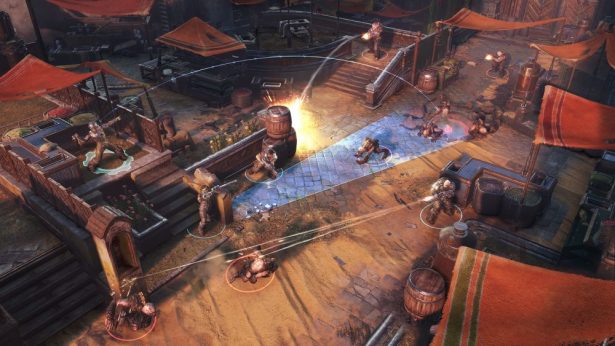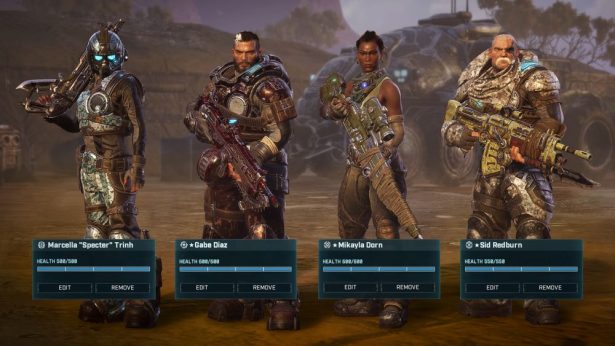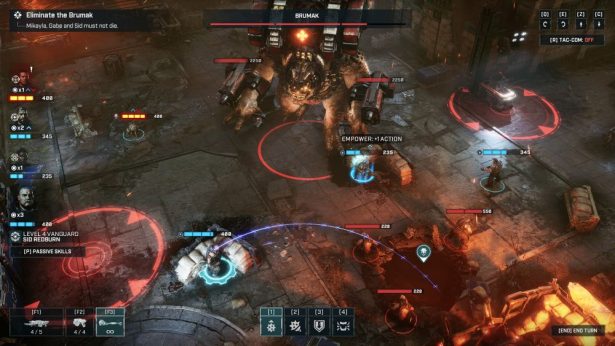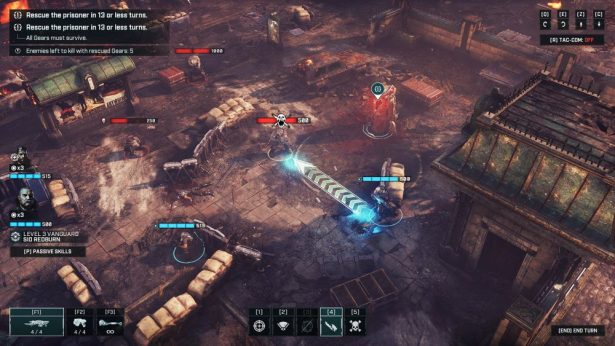This is not the first time Microsoft has successfully experimented with its flagship franchises. So, more than 10 years ago, an excellent real-time strategy Halo: Wars grew out of the Halo series, which received a sequel in 2017, and now the publisher turned its attention to Gears of War and released the turn-based game in Gears series – a prequel to the entire series, directly related to the plot of the fourth and fifth Gears.
Introduction to the Game
Tactics still takes place on the distant planet Sera. The events of the game start one year after the Emergence Day, when the Locust Horde began their attack on humanity, and twelve years before the events of the first part of Gears of War.

The plot revolves around Gabe Diaz, father of Kate Diaz, the main character of Gears 5. On the orders of Richard Prescott, chairman of the Coalition, Gabe must assemble a squad of Gears, and then track down and destroy one of the leaders of the Locust – the brutal Ukkon, responsible for creating the Horde bestiary.
The plot of Gears Tactics is simple and, in general, conveys the whole essence of the local conflict, which really boils down to a banal “find and destroy”. Nevertheless, the story itself has enough plot twists, albeit predictable, but it is still quite interesting to follow what is happening on the screen.
In addition, the local script periodically refers to the numbered games of the series, adding additional context to them. So, Gears Tactics not only acts as a nominal prequel, which tells about some new events, but also significantly expands the world of Gears.
Plot of the Game
The story itself is divided into three acts, each of which, in turn, is divided into chapters. The chapter has story and filler missions. In this case, the latter are mandatory, which significantly affects the perception of the game.
If at first Gears Tactics pleasantly surprises with every new task, then by the end of the second act fillers start to frankly tire. Firstly, there are not so many types of them: either release the hostages, then collect resources, then protect supplies.

And although the modifiers of the tasks change every time (for example, you cannot use grenades, or you need to take a certain hero on a task), and new enemies appear, this does not really affect what is happening, since the pattern of completing such missions is about the same.
And after a dozen hours you complete them near automatically. Secondly, all this greatly affects the pace of the narrative, which sags in the third act, when, in fact, before the final battle, you have to carry out monotonous assignments for a long time, as if preparing for a fight and farming resources.
Half of the game you feel like you are playing boring slot machines and not the great gambling games on Bgaoc.
Gameplay
As a turn-based tactic game, Gears Tactics most closely resembles the modern XCOM dilogy. A squad of several fighters (from 1 to 4) is sent on tasks. Each fighter has his own class with a unique set of skills – there are five classes in the game: scout, vanguard, heavy infantry, sniper and support.
The number of actions per fighter’s turn is limited, almost all abilities have a cooldown, and the probability of hitting the enemy still depends on various factors: for example, the presence of cover or the distance to the target. But then the differences begin, advantageous against the background of Firaxis’ creations.
In Gears Tactics, fighters move freely around locations, since the latter are not divided into cells. Each hero has three action points per turn, which can be spent as you like or not spent at all: for example, you can activate the “Observation” mode at the very beginning of a soldier’s turn, and then during the enemy’s turn he will shoot at the enemies that are in his field of vision, three times.
In turn, the “Observation” mechanic now not only encourages the heroes to follow any movement, but allows you to choose the direction that the shooter should protect.

The shooting itself also feels more better than in XCOM: it is almost impossible to miss while standing next to the target, as well as with a hit probability of 90% and higher, and even with a 60-70% chance, shots reach the target more often than they miss.
At first glance, it may seem that all these changes significantly simplify the game, but this is not the case. Gears Tactics is focused on fast-paced action as fast as it can be in turn-based games. The battles in the game are very dynamic.
Waves of enemies are constantly arriving. And some opponents are in no way inferior to the squad of Gears: they also hide behind covers, actively use the “Observation” mode, trying to limit the actions of the heroes, and punish for the slightest mistake. That is why Gears Tactics is all about quickly destroying opponents.
After all, if you delay, you can find yourself surrounded by many enemies, who in just one move can destroy your squad. This is especially felt in the battles with local bosses – there are three of them in the game and meeting each of them becomes a real test.
Character Leveling and Customization
But outside the brackets of the action part, the game became a little more straightforward and simpler: the developers threw out the base management and the entire economic component, instead focusing on recruiting and improving soldiers, as well as customizing equipment. So, each soldier of the squad has a level.
For each new level, he receives ability points to unlock skills, which are divided into two types: passive (for example, an increase in critical damage by 100% when hitting an enemy with full health) and active (for example, restoring 100 health to whole squad).
In turn, equipment in the game is represented by armor, which affects the parameters of your squad, and modules that change the combat characteristics of a weapon and sometimes endow it with additional effects (for example, the ability to knock the enemy back when hit).

New equipment can be obtained for completing missions and from containers that are awarded for completing additional mission conditions – no microtransactions! The containers are divided into grades (from common to legendary). Each chest contains one piece of equipment of the corresponding grade.
The solution, frankly speaking, is extremely strange, but does not spoil the overall impression of the game. First, there is no shortage of equipment. Secondly, this element of randomness makes you equally follow all the fighters, pay attention to each class and constantly experiment with the tactics, capabilities of each hero and the composition of the squad for the mission, making the gameplay more diverse.
Conclusion
Gears Tactics skillfully adapts the classic Gears of War formula for a new genre, transforming a fast-paced third-person shooter into an equally dynamic turn-based tactics with an emphasis on linear storytelling, as well as fast and brutal action.
The general impression is spoiled only by the obligatory monotonous filler missions and, as a result, a slightly prolonged story campaign.
- Clover Retribution Codes: Free Goodies to Redeem [NEW UPDATE!] - February 12, 2025
- BRAND NEW Black Grimoire Legacy Roblox Codes [UPDATED!] - February 11, 2025
- Black Grimoire Odyssey Codes & Trello [UPDATED!] - February 11, 2025

